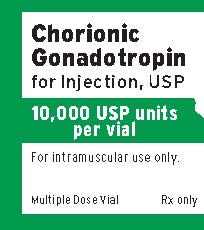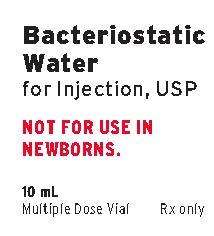CHORIONIC GONADOTROPIN kit
Chorionic Gonadotropin by
Drug Labeling and Warnings
Chorionic Gonadotropin by is a Prescription medication manufactured, distributed, or labeled by Fresenius Kabi USA, LLC. Drug facts, warnings, and ingredients follow.
Drug Details [pdf]
- SPL UNCLASSIFIED SECTION
-
DESCRIPTION:
Human chorionic gonadotropin (HCG), a polypeptide hormone produced by the human placenta, is composed of an alpha and a beta sub-unit. The alpha sub-unit is essentially identical to the alpha sub-units of the human pituitary gonadotropins, luteinizing hormone (LH) and follicle-stimulating hormone (FSH), as well as to the alpha sub-unit of human thyroid-stimulating hormone (TSH). The beta sub-units of these hormones differ in amino acid sequence. Chorionic gonadotropin is obtained from the human pregnancy urine. It is standardized by a biological assay procedure.
Chorionic Gonadotropin for Injection, USP is available in multiple dose vials containing 10,000 USP units with accompanying Bacteriostatic Water for Injection for reconstitution. When reconstituted with 10 mL of the accompanying diluent each vial contains:
Chorionic gonadotropin 10,000 units
mannitol 100 mg
benzyl alcohol 0.9%
water for injection q.s.
Buffered with dibasic sodium phosphate and monobasic sodium phosphate. Hydrochloric acid and/or sodium hydroxide may have been used for pH adjustment (6.0-8.0). Nitrogen gas is used in the freeze drying process.
-
CLINICAL PHARMACOLOGY:
The action of HCG is virtually identical to that of pituitary LH, although HCG appears to have a small degree of FSH activity as well. It stimulates production of gonadal steroid hormones by stimulating the interstitial cells (Leydig cells) of the testis to produce androgens and the corpus luteum of the ovary to produce progesterone. Androgen stimulation in the male leads to the development of secondary sex characteristics and may stimulate testicular descent when no anatomical impediment to descent is present. This descent is usually reversible when HCG is discontinued. During the normal menstrual cycle, LH participates with FSH in the development and maturation of the normal ovarian follicle, and the mid-cycle LH surge triggers ovulation. HCG can substitute for LH in this function. During a normal pregnancy, HCG secreted by the placenta maintains the corpus luteum after LH secretion decreases, supporting continued secretion of estrogen and progesterone and preventing menstruation. HCG HAS NO KNOWN EFFECT ON FAT MOBILIZATION, APPETITE OR SENSE OF HUNGER, OR BODY FAT DISTRIBUTION.
-
INDICATIONS AND USAGE:
HCG HAS NOT BEEN DEMONSTRATED TO BE EFFECTIVE ADJUNCTIVE THERAPY IN THE TREATMENT OF OBESITY. THERE IS NO SUBSTANTIAL EVIDENCE THAT IT INCREASES WEIGHT LOSS BEYOND THAT RESULTING FROM CALORIC RESTRICTION, THAT IT CAUSES A MORE ATTRACTIVE OR ‘‘NORMAL’’ DISTRIBUTION OF FAT, OR THAT IT DECREASES THE HUNGER AND DISCOMFORT ASSOCIATED WITH CALORIE-RESTRICTED DIETS.
- Prepubertal cryptorchidism not due to anatomical obstruction. In general, HCG is thought to induce testicular descent in situations when descent would have occurred at puberty. HCG thus may help predict whether or not orchiopexy will be needed in the future. Although, in some cases, descent following HCG administration is permanent, in most cases, the response is temporary. Therapy is usually instituted between the ages four and nine.
- Selected cases of hypogonadotropic hypogonadism (hypogonadism secondary to a pituitary deficiency) in males.
- Induction of ovulation and pregnancy in the anovulatory, infertile woman in whom the cause of anovulation is secondary and not due to primary ovarian failure, and who has been appropriately pretreated with human menotropins.
- CONTRAINDICATIONS:
-
WARNINGS:
HCG should be used in conjunction with human menopausal gonadotropins only by physicians experienced with infertility problems who are familiar with the criteria for patient selection, contraindications, warnings, precautions and adverse reactions described in the package insert for menotropins. The principal serious adverse reactions are: (1) Ovarian hyperstimulation, a syndrome of sudden ovarian enlargement, ascites with or without pain and/or pleural effusion, (2) Rupture of ovarian cysts with resultant hemoperitoneum, (3) Multiple births and (4) Arterial thromboembolism.
Anaphylaxis and other hypersensitivity reactions have been reported with urinary-derived HCG products.
-
PRECAUTIONS:
General
Induction of androgen secretion by HCG may induce precocious puberty in patients treated for cryptorchidism. Therapy should be discontinued if signs of precocious puberty occur.
Since androgens may cause fluid retention, HCG should be used with caution in patients with cardiac or renal disease, epilepsy, migraine or asthma.
Drug/Laboratory Test Interactions
Chorionic gonadotropin may interfere with radioimmunoassay for gonadotropins, particularly luteinizing hormone.
Carcinogenesis, Mutagenesis, Impairment of Fertility
Long-term studies in animals have not been performed to evaluate the carcinogenic or mutagenic potential of chorionic gonadotropin.
Pediatric Use
Safety and effectiveness of chorionic gonadotropin in children below the age of four have not been established.
Pregnancy
Teratogenic Effects: Pregnancy Category C– Chorionic gonadotropin may cause fetal harm when administered to a pregnant woman. Defects of forelimbs and central nervous system and alterations in sex ratio have been reported in mice receiving combined gonadotropin and chorionic gonadotropin therapy in dosages to induce superovulation. Multiple ovulations with resulting plural gestations (mostly twins) have been reported to occur in approximately 20% of pregnancies when conception has followed chorionic gonadotropin therapy.
- ADVERSE REACTIONS:
-
DOSAGE AND ADMINISTRATION:
Intramuscular Use Only
The dosage regimen employed in any particular case will depend upon the indication for use, the age and weight of the patient and the physician’s preference. The following regimens have been advocated by various authorities.
Prepubertal Cryptorchidism Not Due To Anatomical Obstruction
- 4,000 USP units three times weekly for three weeks.
- 5,000 USP units every second day for four injections.
- 15 injections of 500 to 1,000 USP units over a period of six weeks.
- 500 USP units three times weekly for four to six weeks. If this course of treatment is not successful, another is begun one month later giving 1,000 USP units per injection.
Selected Cases Of Hypogonadotropic Hypogonadism In Males
- 500 to 1,000 USP units three times a week for three weeks, followed by the same dose twice a week for three weeks.
- 4,000 USP units three times weekly for six to nine months, following which the dosage may be reduced to 2,000 USP units three times weekly for an additional three months.
Induction of ovulation and pregnancy in the anovulatory, infertile woman in whom the cause of anovulation is secondary and not due to primary ovarian failure and who has been appropriately pretreated with human menotropins (see prescribing information for menotropins for dosage and administration for that drug product). 5,000 to 10,000 USP units one day following the last dose of menotropins. (A dosage of 10,000 units is recommended in the labeling for menotropins.)
IMPORTANT: USE COMPLETELY WITHIN 60 DAYS AFTER RECONSTITUTION. REFRIGERATE AFTER RECONSTITUTION.
- DIRECTIONS FOR RECONSTITUTION:
-
HOW SUPPLIED:
Chorionic Gonadotropin for Injection, USP, lyophilized, is supplied in two-vial packages including Bacteriostatic Water for Injection as diluent as follows:
Product
No.
NDC
No.
325011 63323-030-11 One carton containing Chorionic Gonadotropin for Injection, USP, 10,000 USP units per vial in a 10 mL multiple dose vial with accompanying diluent. 25021
63323-025-10
Chorionic Gonadotropin for Injection, USP, 10,000 USP units per vial in a 10 mL multiple dose vial with accompanying diluent in packages of 10.
The product is assayed in accord with the USP method and potencies refer to USP units (International Units) defined in terms of the USP Chorionic Gonadotropin Reference Standard.
Store at 20° to 25°C (68° to 77°F) [see USP Controlled Room Temperature].
- SPL UNCLASSIFIED SECTION
-
PRINCIPAL DISPLAY PANEL
PACKAGE LABEL - PRINCIPAL DISPLAY - Chorionic Gonadotropin 10 mL Multiple Dose Vial Label
Chorionic Gonadotropin for Injection, USP
10,000 USP units per vial
For intramuscular use only.
Multiple Dose VialRx only

PACKAGE LABEL - PRINCIPAL DISPLAY - Bacteriostatic Water 10 mL Multiple Dose Vial Label
Bacteriostatic Water for Injection, USP
NOT FOR USE IN NEWBORNS.
10 mL
Multiple Dose Vial
Rx only

PACKAGE LABEL - PRINCIPAL DISPLAY - Chorionic Gonadotropin 10 mL Multiple Dose Vial Carton Panel
Chorionic Gonadotropin for Injection, USP
10,000 USP units per vial
For intramuscular use only.With Bacteriostatic Water for injection, USP as diluent
Rx only
Two-vial set10 mL
Multiple Dose Vials

-
INGREDIENTS AND APPEARANCE
CHORIONIC GONADOTROPIN
chorionic gonadotropin kitProduct Information Product Type HUMAN PRESCRIPTION DRUG Item Code (Source) NDC: 63323-030 Packaging # Item Code Package Description Marketing Start Date Marketing End Date 1 NDC: 63323-030-11 1 in 1 CARTON; Type 1: Convenience Kit of Co-Package 04/21/2011 Quantity of Parts Part # Package Quantity Total Product Quantity Part 1 1 VIAL, MULTI-DOSE 10 mL Part 2 1 VIAL, MULTI-DOSE 10 mL Part 1 of 2 CHORIONIC GONADOTROPIN
chorionic gonadotropin injectionProduct Information Route of Administration INTRAMUSCULAR Active Ingredient/Active Moiety Ingredient Name Basis of Strength Strength CHORIOGONADOTROPIN ALFA (UNII: 6413W06WR3) (CHORIOGONADOTROPIN ALFA - UNII:6413W06WR3) CHORIOGONADOTROPIN ALFA 10000 [USP'U] in 10 mL Inactive Ingredients Ingredient Name Strength MANNITOL (UNII: 3OWL53L36A) BENZYL ALCOHOL (UNII: LKG8494WBH) SODIUM PHOSPHATE, DIBASIC (UNII: GR686LBA74) SODIUM PHOSPHATE, MONOBASIC (UNII: 3980JIH2SW) SODIUM HYDROXIDE (UNII: 55X04QC32I) HYDROCHLORIC ACID (UNII: QTT17582CB) Packaging # Item Code Package Description Marketing Start Date Marketing End Date 1 10 mL in 1 VIAL, MULTI-DOSE; Type 0: Not a Combination Product Marketing Information Marketing Category Application Number or Monograph Citation Marketing Start Date Marketing End Date BLA BLA017067 04/21/2011 Part 2 of 2 WATER
water injectionProduct Information Route of Administration INTRAMUSCULAR Inactive Ingredients Ingredient Name Strength HYDROCHLORIC ACID (UNII: QTT17582CB) WATER (UNII: 059QF0KO0R) BENZYL ALCOHOL (UNII: LKG8494WBH) SODIUM HYDROXIDE (UNII: 55X04QC32I) Packaging # Item Code Package Description Marketing Start Date Marketing End Date 1 10 mL in 1 VIAL, MULTI-DOSE; Type 0: Not a Combination Product Marketing Information Marketing Category Application Number or Monograph Citation Marketing Start Date Marketing End Date BLA BLA017067 04/21/2011 Marketing Information Marketing Category Application Number or Monograph Citation Marketing Start Date Marketing End Date BLA BLA017067 04/21/2011 Labeler - Fresenius Kabi USA, LLC (608775388) Establishment Name Address ID/FEI Business Operations Fresenius Kabi USA, LLC 023648251 MANUFACTURE(63323-030)
© 2025 FDA.report
This site is not affiliated with or endorsed by the FDA.
